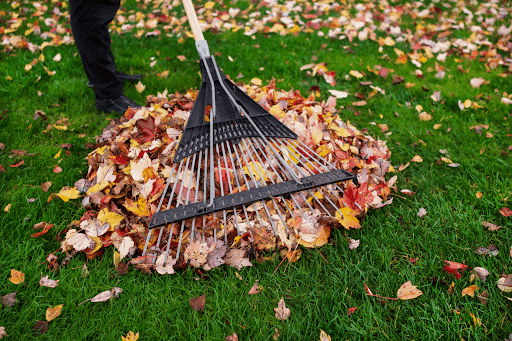
As autumn leaves begin to paint the landscape in vibrant hues, you start to think about preparing your outdoor space for the cooler months ahead. Fall lawn care is vital for maintaining a healthy yard and garden throughout the winter and into spring. This guide will explore nine essential lawn and garden tools every homeowner should have in their fall maintenance arsenal.
1. Leaf Rake

A sturdy leaf rake is perhaps the most important fall lawn care tool. It’s perfect for gathering fallen leaves, spreading mulch, and even lightly dethatching turf. Raking leaves prevents them from smothering the grass underneath. Leaves left on the lawn for extended periods can create matted areas that are prone to fungal diseases and other lawn problems.
Address any fungal grass infections promptly. Proper raking can help prevent fungus problems, but if they do occur, look into trusted methods to combat fungal infections in your lawn.
2. Leaf Blower

A leaf blower is a time-saving alternative to raking, especially for larger properties. These powerful tools use a strong air stream to move debris efficiently. Cordless leaf blowers offer the added benefit of unrestricted movement.
Leaf blowers are particularly useful for consolidating leaf piles, clearing debris from hard-to-reach areas such as gutters and downspouts, and removing leaves from flower beds without disturbing mulch or plants.
Consider weight, noise level, and power source to find the best leaf blower for you.
3. Wheelbarrow

A wheelbarrow is an indispensable tool for transporting heavy loads around the yard. During fall, it becomes especially useful for moving piles of raked leaves, transporting mulch to garden beds, and hauling compost or soil amendments.
Invest in a durable wheelbarrow with a sturdy wheel and comfortable handles to make fall yard work much less strenuous. If you only need a wheelbarrow once, look into renting one.
4. Hand Pruners

Hand pruners, also known as pruning shears, are vital for maintaining plant health and appearance during fall. These tools come in different styles, each suited for specific tasks:
- Bypass pruners: Ideal for making clean cuts on live stems and branches
- Anvil pruners: Best for deadwood and thicker, dried-out stems
Proper fall pruning helps plants conserve energy during winter dormancy. Research which plants in your garden benefit from fall pruning, as some may require minimal or no pruning at all. This PennState Extension guide explains which plants to leave alone before the winter season.
5. Hand Trowel

A hand trowel is a versatile tool for fall gardening tasks. Its compact size and pointed tip make it perfect for digging holes for planting spring-flowering bulbs, removing spent annuals from garden beds, and transplanting or dividing perennials.
Look for a hand trowel with a comfortable grip and a durable, rust-resistant blade. Stainless steel trowels are often a good choice because they’re long lasting and easy to clean.
6. Garden Fork

A garden fork is an excellent tool for loosening soil and breaking up compacted areas in the garden. In the fall, it’s particularly useful for aerating garden beds before winter, harvesting vegetables such as potatoes and carrots, and turning compost piles to promote decomposition.
The sturdy tines of a garden fork can penetrate tough soil more easily than a shovel, making it invaluable for fall garden preparation.
7. Hand Weeder

A hand weeder, with its V-shaped prong, is designed to remove weeds from the root. We recommend tackling weeds in the fall, as many are actively growing and more vulnerable to removal. Using a hand weeder helps prevent weeds from setting seed and spreading, reduces competition for nutrients, and prepares garden beds for spring planting.
Some hand weeders — like this one from Fiskars — provide extra leverage for tough weeds.
8. Leaf Scoops

Leaf scoops make gathering and moving large volumes of leaves much easier. They’re particularly useful in conjunction with other fall cleanup tools:
- Pair them with a rake to quickly transfer leaf piles to a wheelbarrow or compost bin.
- Use them to scoop leaves directly from the ground after using a leaf blower.
- Employ them to move mulch or other loose materials around the garden.
Leaf scoops can protect hands from debris, but we still recommend wearing gloves for added protection.
9. Mulcher

Mulchers helps deal with large quantities of fallen leaves. They shred leaves into fine particles you can use as a nutrient-rich mulch for garden beds, an addition to compost piles for faster decomposition, and as a protective layer for overwintering plants.
Some mulchers come as part of a versatile combination tool that also functions as a leaf blower and vacuum.
Additional Fall Lawn and Garden Tools
In addition to the tools we’ve outlined above, others can complement your fall lawn and garden routine. You may use these tools less frequently, but they can ease your gardening experience and enhance the health of your lawn and garden.
Lawn Aerator
Aerating your lawn in the fall can help improve soil structure, enhance root growth, and reduce soil compaction. Lawn aerators come in various forms, including manual, spike, and core aerators. Manual aerators are best suited for small lawns, while motorized aerators are great for larger yards.
Garden Kneeler and Seat
Gardening can be physically demanding. A garden kneeler and seat can provide comfort and support, reducing strain on your knees and back. Look for a foldable design that’s easy to store and transport.
Compost Bin
Fall is an excellent time to start composting, as you’ll have an abundance of fallen leaves, spent plants, and other organic material. A compost bin helps you manage your compost efficiently and can provide nutrient-rich compost for your garden by spring. Choose a bin with good ventilation and easy access for turning the compost material.






Leave a Reply